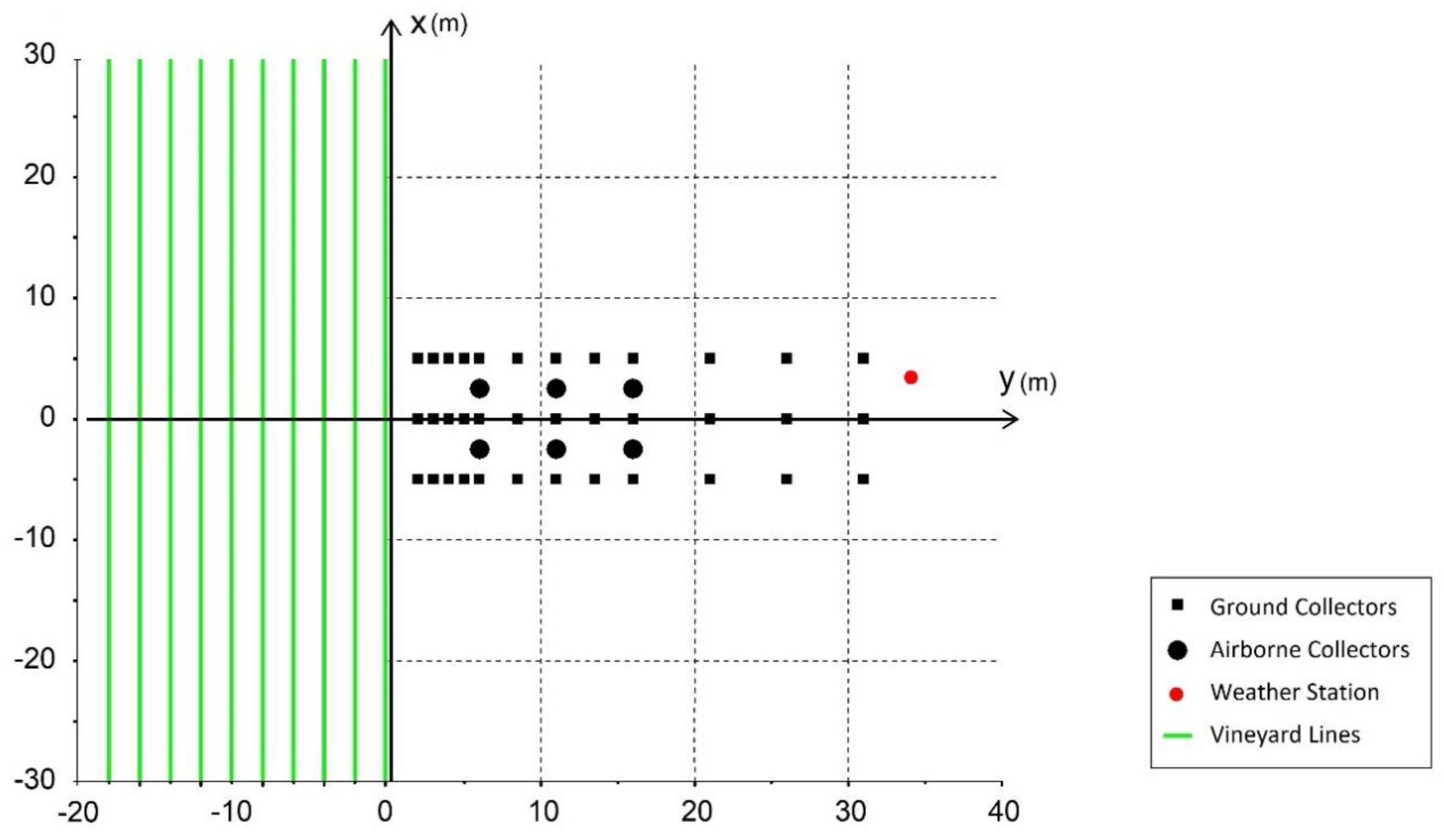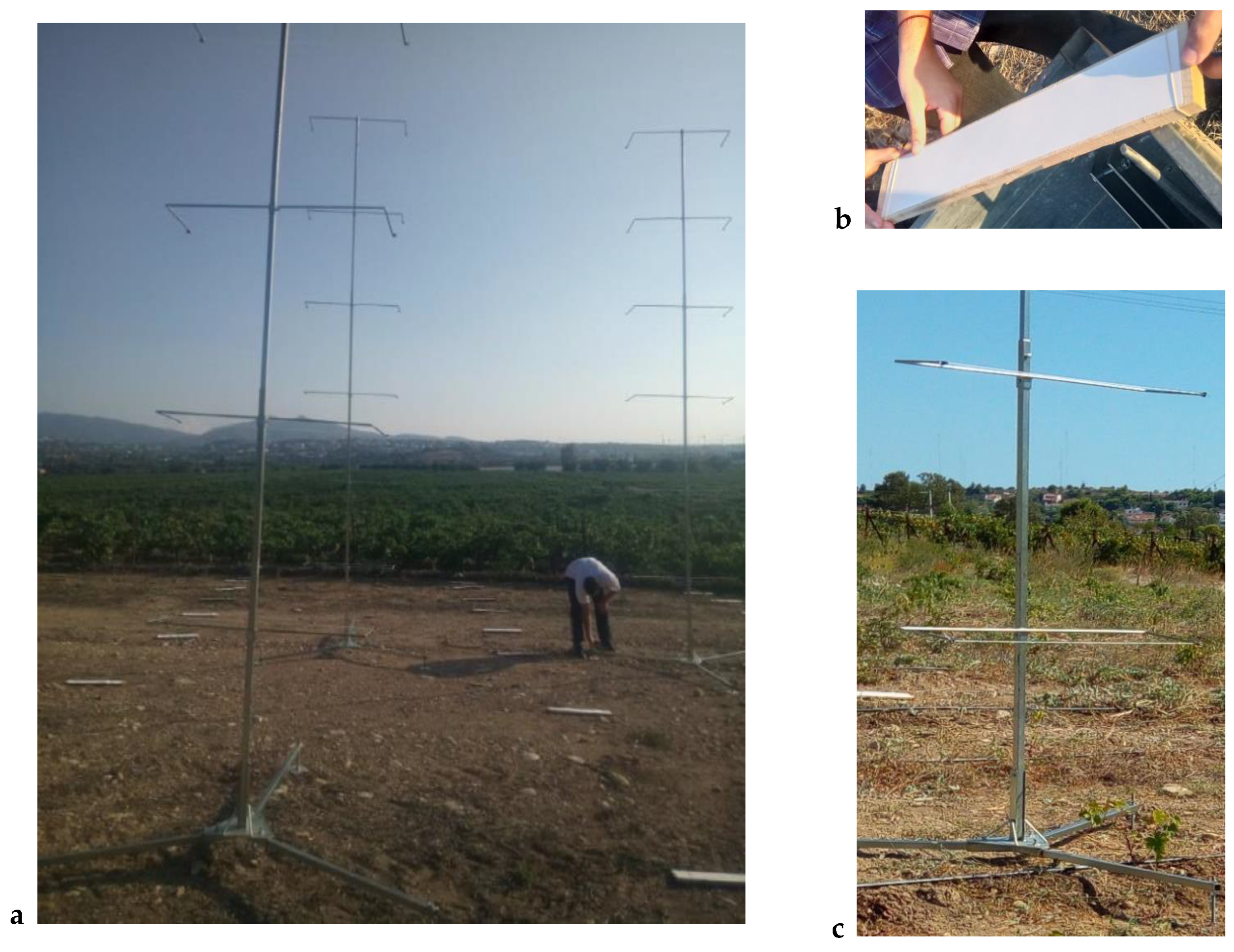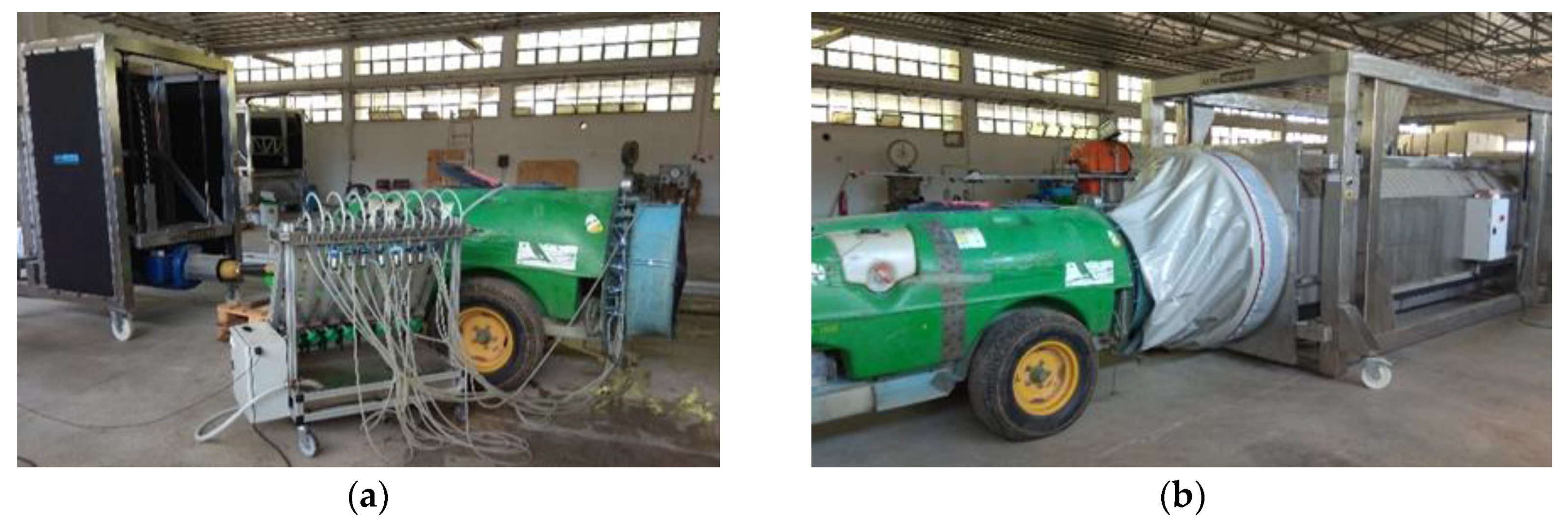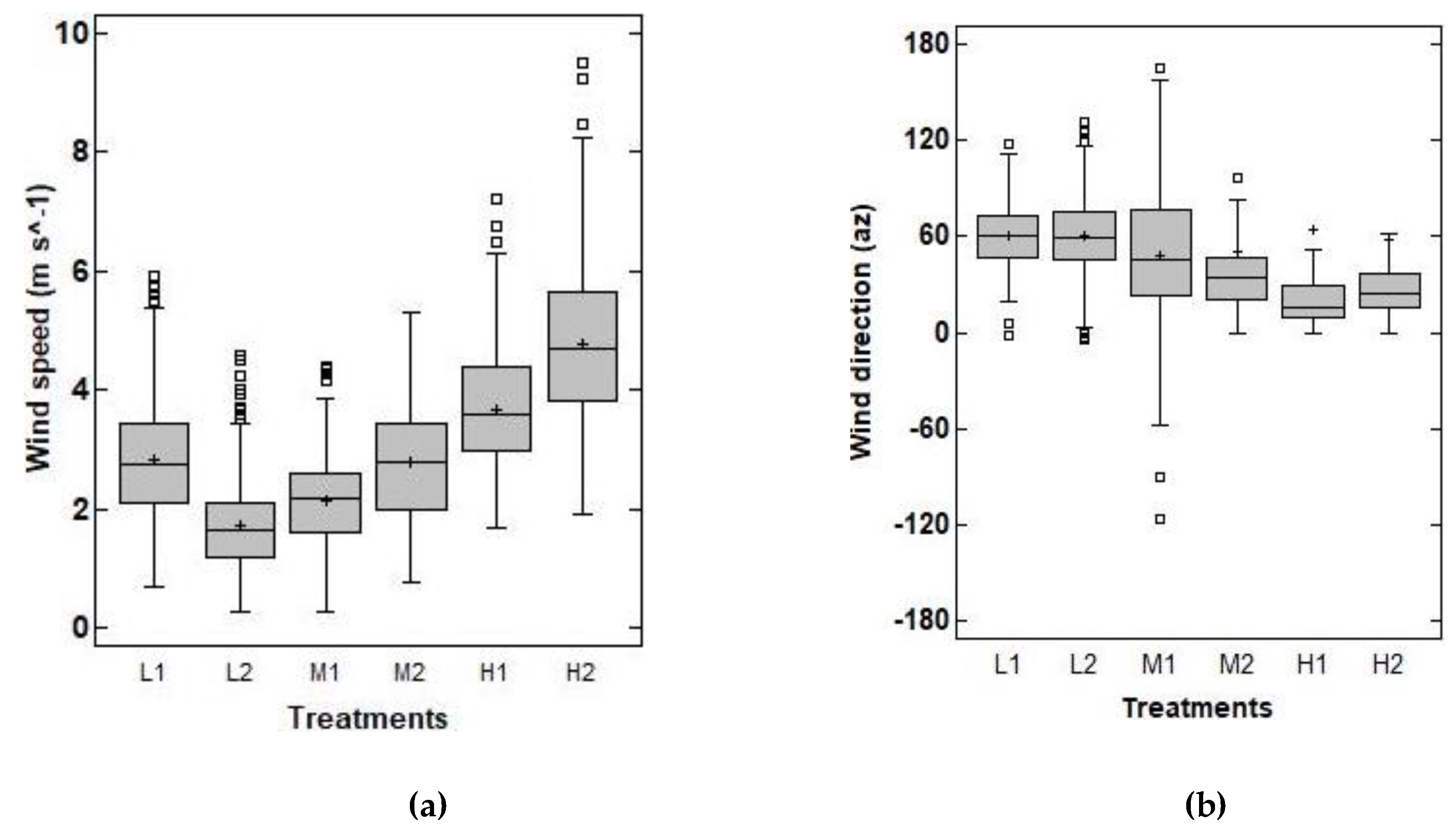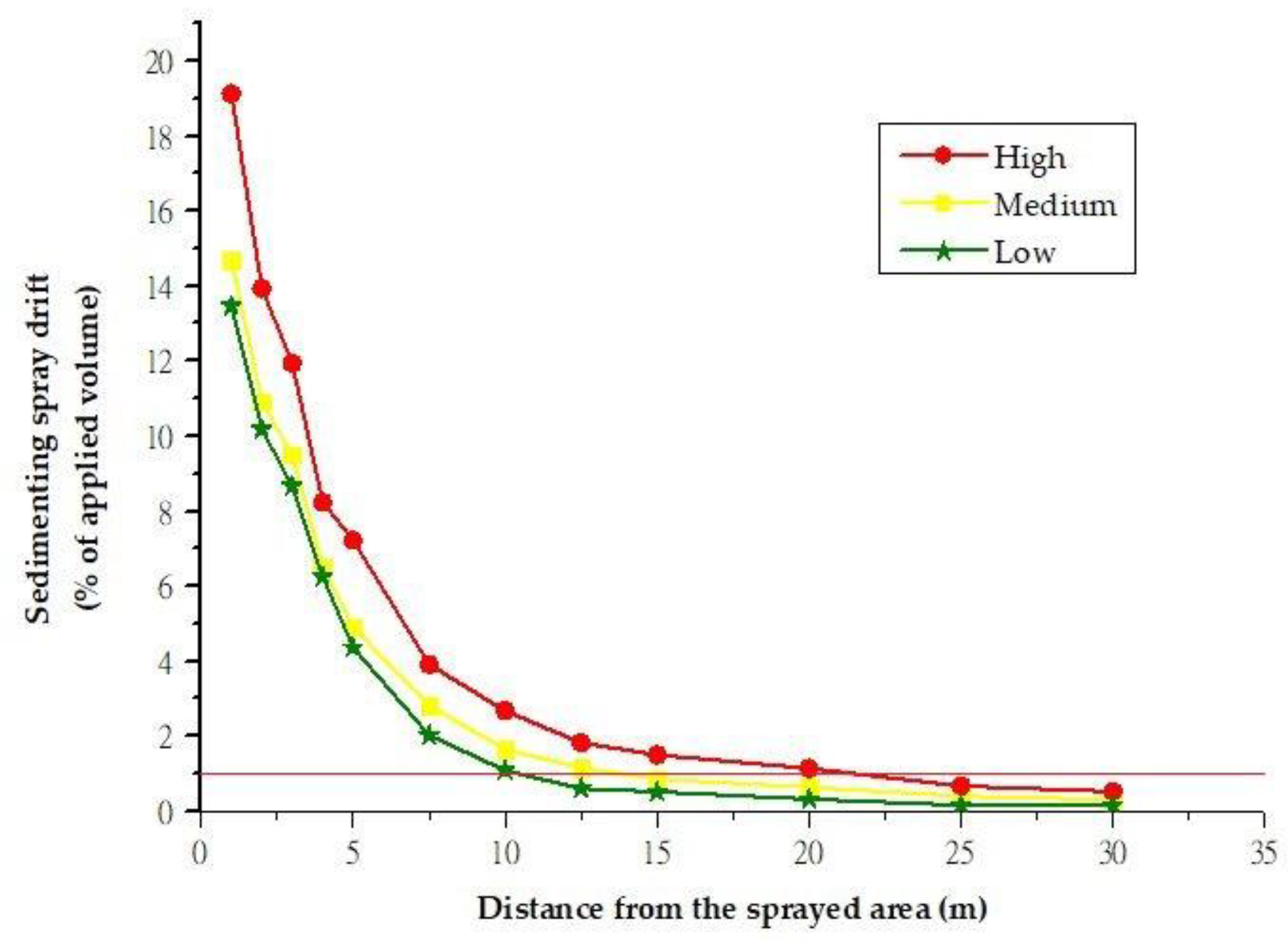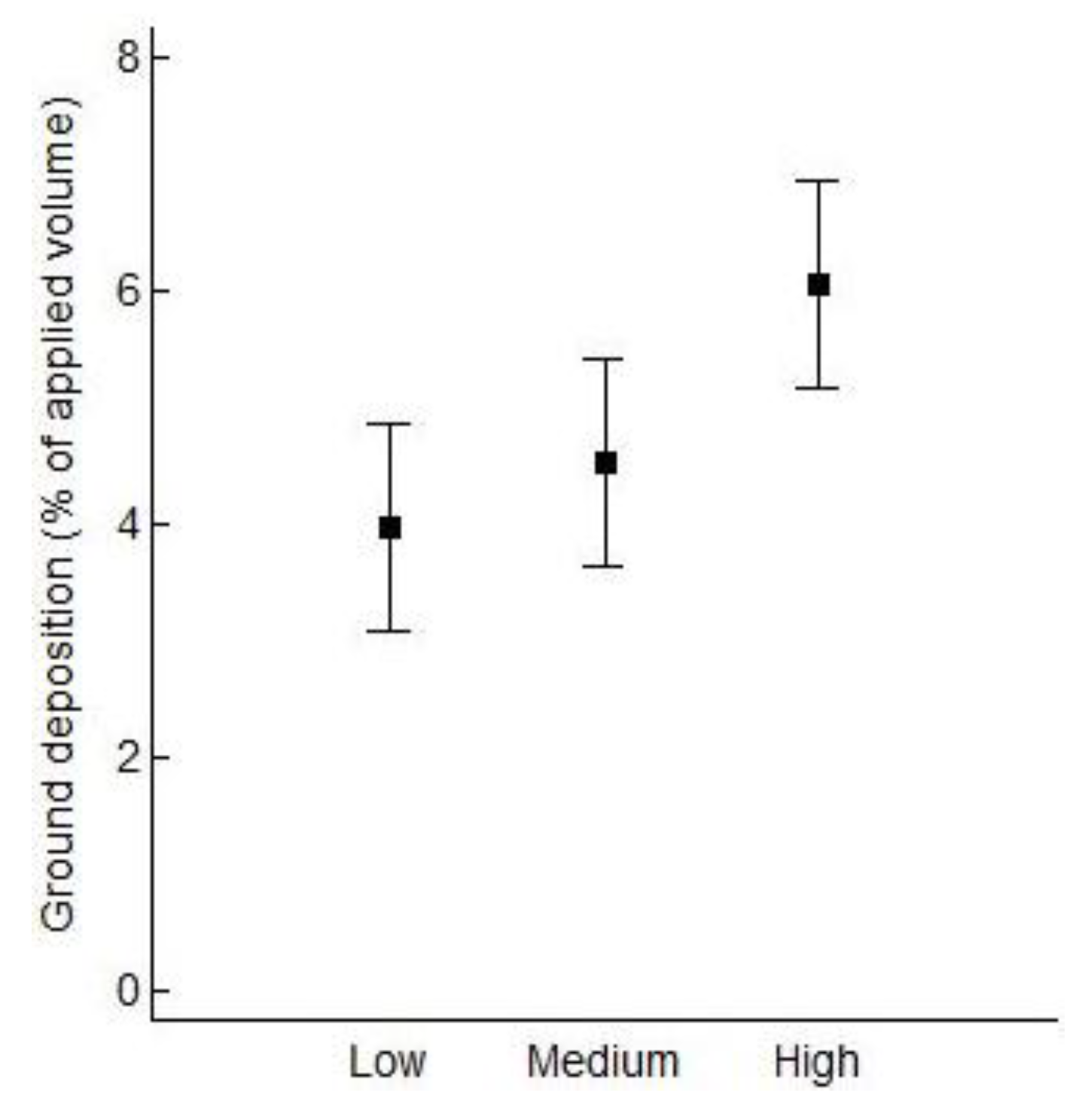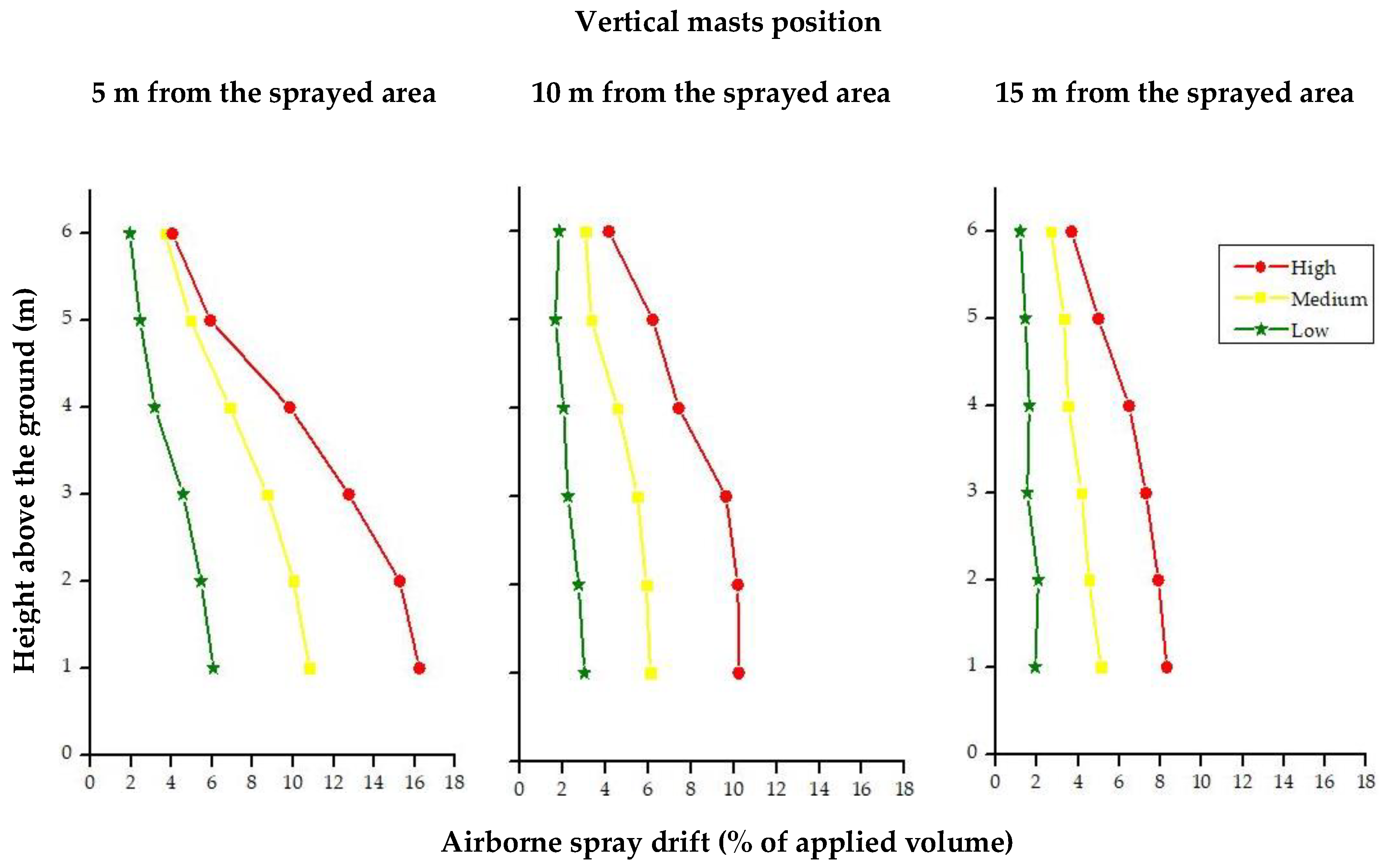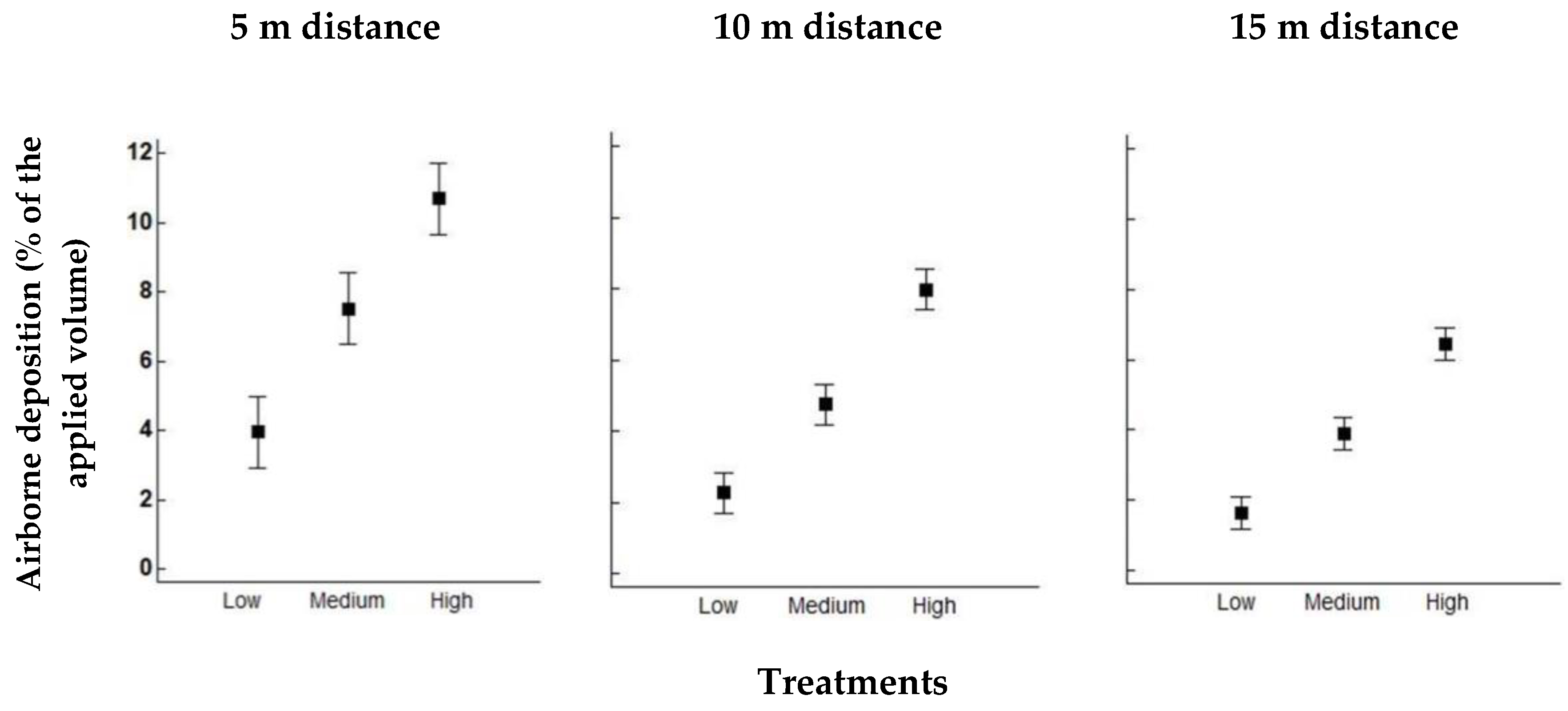1. Introduction
Chemical crop protection is one of the most important factors in agricultural production, as global potential crop yield is diminished by pests up to 40%, a figure that would be twice as large if no plant protection products (PPPs) were used [
1]. The benefits from crop protection are also undeniably significant in regards to improved food security and the reduction of labor [
2]. However, as most PPPs are applied in the field by spraying, due to low cost and efficient performance [
3], serious PPP losses are a side effect of chemical crop protection due to run-off, leaching, evaporation, and spray drift, putting the health of the environment, animals, and humans at risk [
4].
Spray drift is the quantity of PPPs that is carried out by air currents from the sprayed area during the spraying application [
5]. Spray drift is an important and costly (environmentally and economically) problem that is hard to control and may cause the PPPs to be deposited in off-target areas. The consequences can be serious, such as surface water contamination, air pollution, damage to sensitive nearby crops and other susceptible off-target areas, residues of chemical substances in food and feed commodities, health risks for animals and people (farm workers, bystanders, and passers-by), nearby urban or natural area contamination, and reduced PPP effectiveness due to lower dose than intended on the targeted crops [
6,
7,
8,
9,
10]. Additionally, the financial burden resulting from spray drift due to increased inputs is very high [
11].
There are many factors that contribute to spray drift and several of them are interrelated. Some factors can be controlled by the sprayer operator, while others cannot be controlled. These factors can be grouped into the following categories: (i) Equipment and application techniques (i.e., sprayer type, size and type of nozzles, spray pressure, spray volume rate, air flow rate, driving speed, sprayer’s setup, etc.); (ii) weather conditions during application (i.e., wind speed and direction, temperature, relative humidity, and stability of air at the application site); (iii) spray characteristics, (i.e., volatility and viscosity of the PPP formulation; (iv) operator’s care, attitude, and skill; and (v) characteristics and geometry of the crop (i.e., foliage, density, dimensions, etc.) [
12,
13,
14,
15,
16,
17].
Among the technical factors that affect spray drift, the most important is droplet size [
18] and more particularly the percentage of fine spray droplets [
19,
20,
21,
22]. Considering the pressure atomization, droplet size depends on the nozzle design, orifice size, operating pressure, and the physical properties of the PPP formulation and spray additives [
23,
24]. The smaller a spray droplet, the longer it remains airborne, and the higher the possibility for it to be carried away by crosswind [
25]. Droplets with diameter smaller than 100 μm contribute significantly to drift losses [
26,
27]. Forward speed has also a clear effect on spray drift, where the higher the driving speed the greater the spray drift, both for airborne drift and for ground deposition [
28]. Regarding bush and tree sprayers, among the various application operating parameters that affect spray drift, those that concern spray generation (nozzle type and pressure) and droplet transport to the canopy (air fan volume, speed, orientation) are of great importance [
29].
Environmental conditions influence spray drift and cannot be controlled by the sprayer operator. These factors need to be taken into consideration and be monitored before and during the PPP application. Among the meteorological factors affecting spray drift, wind velocity has the greatest impact, while wind direction plays also an important role. There is a strong positive correlation between wind speed and spray drift deposition [
30]. Higher wind speeds result in more drift at greater distances [
31]. Summer [
32] pointed out that wind speed should not exceed 16 km h
−1 (4.44 m s
−1) to continue spraying. According to da Cunha et al. [
33], the maximum permissible wind speed for spraying is 12 km h
−1 (3.33 m s
−1), while Maciel et al. [
34] also proposed that spraying operation should be performed with wind speeds ranging between 2 and 12.8 km h
−1 (0.55 to 3.55 m s
−1). It should be noted that different wind speeds and directions have also been reported to contribute to uneven spray distribution between the left and right side of the sprayer [
35]. In addition, large fluctuations in wind direction increase the unpredictability of droplet travel direction and the amount of dilution due to atmospheric turbulence [
36].
Air temperature and relative humidity during the spraying operation play also key role in spray drift. Low relative humidity and/or high air temperature can reinforce evaporation by decreasing the droplet size, especially small droplets, having, as a result, decreased sedimentation velocity and droplets more prone to drift [
37]. Low relative humidity combined with high temperatures contributes to the evaporation of the spray liquid with an impact both on the environment and on the economic viability of the farm [
34]. ISO 22866 standard [
5] considers acceptable conditions for field measurement of spray drift at temperatures ranging from 5 to 35 °C. Da Cunha et al. [
33], pointed out that spraying should be avoided when temperature is above 30 °C and relative air humidity is below 55%. As a rule, if the relative humidity is above 70%, the conditions are ideal for spraying, and if the relative humidity is below 50%, it is quite critical and requires special attention [
32]. Generally, spray drift can be significantly reduced by spraying at low wind speed, low temperature, with low turbulence, at times of low sun radiation and at high relative humidity [
38].
Moreover, it should be noted that during rain or shortly before it occurs, PPP application should be avoided due to leaching risk from the crop canopy before the active substance is able to act [
39], polluting the soil and the underground water resources.
Since the negative effect of spray drift has been recognized, there is a need for harmonized mitigation measures to reduce human health and environmental impact. Such measures have been developed and can be divided into three classes [
40,
41,
42]: (i) The use of no-spray or even no-crop buffer zones; (ii) the reduction of exposure using vegetative or artificial windbreaks, and (iii) the application of drift-reducing technology, such as drift-reducing nozzles and spray additives to coarsen the droplet size distribution, as well as shielded and band sprayers. In addition, the EU legislation has been adjusted in this direction, with Directive 2009/128/EC [
43] establishing a framework to achieve sustainable use of PPPs, while Directive 2009/127/EC [
44] specifies that sprayers should be designed and constructed to ensure that PPPs are deposited on target areas, to minimize losses to other areas and to prevent drift. USA has also set certain measures for spray drift prevention that are in the same direction as the EU legislation [
45].
In recent years, several attempts have been made to reduce spray drift through predicting weather conditions and creating automated spray drift reduction systems. Such systems may collect meteorological data from either ground meteorological stations or geostationary satellites and predict drift or provide information to the user on how to treat and regulate the sprayer. The frequency of meteorological data gathering is crucial to optimize weather prediction and develop a reliable spray drift model. As an example, Huang and Thomson [
46] highlighted the importance of knowing meteorological data on 15 min basis than on 1 h basis, as climate conditions can change rapidly, making hourly forecasts unreliable. On-line applications are also used for spray drift prediction and reduction helping farmers make decisions for best practice implementation. For example, Nansen et al. [
47] created an online decision support tool for farmers and agricultural advisors. This tool allows the prediction, measurement, and archiving of spraying coverage, which is quantified using water sensitive filter papers. Spray drift investigation and prediction under a wide range of conditions have been conducted [
48,
49]. A comprehensive model which accurately predicts the downwind movement of spray for given circumstances, including spray liquid characteristics, spray nozzle characteristics, and meteorological conditions, was developed by the US Spray Drift Task Force [
50]. Hong et al. [
51] presented a software application for spray drift estimation using an orchard air-assisted sprayer, through their research study on spray drift prediction. Another case of a spray drift prediction model, which simulates spray drift taking meteorological conditions into consideration, is the one produced by Nsibande et al. [
52] in South Africa.
The aim of this research was to evaluate spray drift in vineyards using a drift risk assessment tool in order to improve the process of PPP application and mitigate spray drift. The spray drift risk assessment tool was developed taking into consideration a similar drift evaluation tool developed in the framework of the TOPPS-Prowadis [
53]. The factors that the tool considers are wind speed and direction, air temperature, and relative humidity. The ultimate goal was to examine the reliability of the tool by measuring the meteorological conditions in the field and assessing ground and airborne spray drift. The evaluation used field trials in a vineyard under the standardized test methodology of ISO 22866:2005 [
5]. The selected vineyard variety for spray drift trials was Savatiano, the most widespread winemaking variety in the Attica region, which has been cultivated for about 4000 years [
54].
2. Materials and Methods
2.1. Spay Drift Risk Assessment Tool
The tool evaluates the potential drift risk from PPP applications using air-assisted sprayers for different meteorological conditions under field conditions in vineyards. The meteorological data input to the tool is obtained from a weather forecast website for the geographic coordinates of the field. The drift evaluation tool can help the farmers or spray contractors to make decisions for PPP applications with high spray efficiency and low spray drift risk to the environment.
The tool is based on the methodology developed from the TOPPS-Prowadis drift evaluation tool [
53], and presents three categories depending on the risk of spray drift to occur:
“Low” indicates that it is possible to apply spraying as the drift will have small/acceptable extent;
“Medium” indicates that there is medium risk of spray drift due to conditions and, the use of drift-reducing technology and/or setting drift-reducing application parameters should be considered;
“High” indicates that there is high risk of spray drift and; therefore, spraying should not be applied.
The tool takes into account limitations related to air temperature, relative humidity, wind speed, and wind direction. Considering the meteorological conditions in Greece and a series of experimental measurements carried out in Greek vineyards, the tool’s limits on weather conditions varied from those used by the TOPPS-Prowadis drift evaluation tool as follows:
Air temperature: The limits between the three categories were set at 25 and 30 °C, while the TOPPS-Prowadis tool uses, as limits, 15 and 25 °C. This is because during the spraying period of vineyards in Greece temperatures vary from 20 °C to above 30 °C.
Relative humidity: The TOPPS-Prowadis tool’s limits between the three categories were maintained and they are 40% and 60%.
Wind speed: The 5 classes of the TOPPS-Prowadis tool were made 3, with the limits between them set at 3 and 4.5 m s−1. The classes of the TOPPS tool which refer to low and medium wind speeds were merged, because during the spraying period the high temperatures do not allow weak winds to occur.
In order to evaluate and categorize the drift risk, the tool combines the values of the meteorological parameters by giving priority to the wind speed.
The above limits and categories apply with the following basic assumptions:
The wind direction is towards the sensitive area.
The canopy crop density is greater than 50%.
There is no rainfall.
The rows are sprayed from two sides and air is blown from two sides to each row.
2.2. Test Site and Crop Characteristics
The experimental field was an organic vineyard at the Agricultural University of Athens farm in Athens, Greece (37°59′06″ N, 23°54′21″ E).
The vineyard has 2.0 m row spacing with 1.6 m spacing of vines along the row to result in a density of 3125 vines ha
−1. The average vine height was about 1.1 m, with the leaves and grapes occupying the zone above ground between 0.3 and 1.2 m. At spraying times, the vines were in full leaf stage (BBCH 83 “Berries developing colors” and BBCH 91 “After harvest; end of wood maturation”) [
55], and the leaf area index (LAI) values were 1.58 and 1.46, respectively.
2.3. Experimental Design
The field experiments were carried out based on the ISO 22866:2005 standard [
5], which set the criteria on the conditions for spray drift measurements. In accordance to this, the directly-sprayed area shall be at least 20 m wide upwind of the edge of the cropped area and the length of the spray track at least twice as the largest downwind sampling distance, and should be symmetrical to the axis of the sampling array. Therefore, every trial was carried out by spraying the ten outer downwind rows of the vineyard along a distance of 60 m, in order to treat a surface of 1200 m
2 (60 × 20 m) (
Figure 1).
The experimental area was open and free of obstructions, other than the target crop (vineyard), as these may affect the airflow in the sampling area [
5]. On the downwind side of the directly-sprayed area, there was bare soil or short vegetation (maximum height 7.5 cm), on which collectors were placed for the estimation of airborne spray drift and sedimenting spray drift [
5] (
Figure 2a).
In each trial, both ground sediment and airborne spray drift downwind to the directly-sprayed area were sampled. The ground collectors were placed at 12 different sampling distances in bare soil at 1, 2, 3, 4, 5, 7.5, 10, 12.5, 15, 20, 25, and 30 m from the edge of the directly-sprayed area (
Figure 1). These distances started from the parallel straight line in front of the last plant row spaced 1 m (half of the row spacing). At each sampling distance, three wooden laths were placed with an upper surface covered in filter paper, Whatman Grade−1, 46 × 8 cm (
Figure 2a,b), counting 36 soil samples per trial (
Figure 1). So, each ground collector had a surface area of 368 cm
2, summing up to a total of 1104 cm
2 collector surface at each distance (the minimum collector area at any distance must be 1000 cm
2 [
5]).
The airborne spray drift was monitored on cylindrical polyethylene lines with an external diameter of 2 mm, length 1 m, and collection area 62.8 cm
2 (
Figure 2c). The measurements were taken at 3 distances, 5, 10, and 15 m, downwind from the edge of the directly-sprayed area (
Figure 1). At each sampling distance, two 6 m high columns were placed, each of which had support structures per meter for the polyethylene lines, thus forming an array of 6 sampling collectors (
Figure 2a,c). Therefore, at each distance there were 12 collectors summing up to a total sampling area of 753.6 cm
2, resulting in 36 collectors per trial.
After each spraying repetition, the ground and air collectors were stored into plastic sachets and sealed in refrigerators for maintenance at the appropriate temperature (4 °C) until their spectrophotometric analysis in the laboratory.
2.4. Meteorological Conditions
Local weather conditions were measured following ISO 22866:2005 [
5], but also to check the reliability of the weather forecast used by the drift risk assessment tool. Wind speed, wind direction, air temperature, and relative humidity were measured during the trials using a meteorological station placed at the edge of the downwind area in the center of the sampling area, 30 m from the sprayed area. Wind speed and direction were measured at a distance of 3 m from the ground, using an ultrasonic anemometer (Campbell Scientific WindSonic1 Gill 2D, Logan, UT, USA). Temperature and relative humidity were measured at two different heights, 2 and 3 m above ground, using two thermo-hygrometer probes (Rotronic HC2A-S3, Hauppauge, NY, USA). All measurements were taken at a frequency of 1 Hz sampling rate and all data were recorded automatically by a data logger (Campbell Scientific CR850, Logan, UT, USA).
The following parameters were calculated for each trial [
5]:
Percentage of wind speed measurements less than 1 m s−1 (must be <10%);
Mean wind direction shall be at 90° ± 30° to the spray track (in this experiment between 0° and 60°) and no more than 30% of results shall be >90° ± 45° to the spray track;
Mean temperatures must be between 5 and 35 °C.
2.5. Treatments and Equipment Application Parameters
A total of six trials were carried out, two were related to the assessment of spray drift with a low risk tool indicator, two with medium, and two tests with high risk tool indicator.
Trials were performed using a trailed air-assisted sprayer for bush and tree crops Archimedes Turbo FS 1000 (“Archimedes” G. Roumeliotis, Aridaia Pellas, Greece), equipped with a 1000 L polyester tank, an axial fan of 800 mm in diameter with a two-speed gearbox and 7 nozzles for each side of the sprayer. The nozzles used were conventional hollow cone Teejet TXA 8002VK, yellow signed, with nominal nozzle flow rate of 1.40 L min
−1 at 1.0 MPa. The real flow rate was closest to the nominal one. It was measured in the Department of Agricultural Engineering, Institute of Soil and Water Resources of the Hellenic Agricultural Organization “DEMETER”, using an electronic measuring device (AAMS-Salvarani BVBA, Maldegem, Belgium) (
Figure 3a). During testing, after adjusting the spray profile to target characteristics by means of water-sensitive paper spread on the vineyard canopy and poles, it was decided to activate a total of 6 nozzles (3 on each side of the sprayer). For all treatments, the working pressure was 1.0 MPa, driving speed 1.61 m s
−1 (5.8 km h
−1), and volume application rate 434 L ha
−1. In all trials the PTO revolution speed was 56.55 rad s
−1 (540 rev min
−1), fan speed 169.65 rad s
−1 (1620 rev min
−1) (fan ratio 1:3), and fan airflow rate 10,000 m
3 h
−1. Fan air flow rate was measured in the Department of Agricultural Engineering, using a measuring tunnel (AAMS-Salvarani BVBA, Maldegem, Belgium) (
Figure 3b).
2.6. Spray Liquid, Sample Extraction, and Spray Drift Estimation
The spray liquid was a solution of clean water and E−102 Tartrazine yellow dye tracer 85% (
w/w) at a concentration of about 4 g L
−1 [
56,
57].
Before each test, a blank sample of filter paper was placed in the sprayed area and collected just before the start of spraying. Two samples of the spray liquid were also collected from the spray tank directly from a nozzle, one at the beginning and one at the end of the test, to determine the precise tracer concentration at the nozzle outlet at each test.
After collecting the samples, they were transferred for analysis to the laboratory. Tartrazine’s concentration in soil and air collectors was studied and quantified using a Shimadzu UV−1800 spectrophotometer, functioning at a wavelength of 426 nm.
Deposits of the spray tracer were extracted from samples using deionized water. For the respective samples the following volumes of deionized water were applied: A total of 40 mL for filter paper from 1 to 5 m distance, 20 mL for filter paper from 7.5 to 30 m distance, and 10 mL for polyethylene lines.
The reading of the spectrophotometer is related to the amount of tracer in solution through a calibration curve. From the reading of the spectrophotometer, the calibration factor, the collector surface area, the spray concentration and the volume of dilution liquid, and the amount of spray deposit per unit area were calculated as follows [
5]:
driftdep = spray drift deposit (μL cm−2)
ρsmpl = spectrophotometer reading of the sample (Abs)
ρblk = spectrophotometer reading of the blanks (collector + deionized water) (Abs)
Fcal = calibration factor (μg L−1)
Vdil = volume of dilution liquid (L)
ρspray = spray concentration of tracer (g L−1)
Acol = collection area of the spray drift collector (cm2)
From this spray drift deposition figure, the percentage of spray drift on a collector can be calculated relating spray drift deposition to the amount applied in the field on the same unit of area, with the following formula:
where β
v is the spray application volume in liters per hectare (L ha
−1) and given by the following equation:
Total nozzle flow rate = number of nozzles used multiplied by the nozzle nominal flow rate (L min−1)
Row spacing = distance between lines (m)
Velocity = velocity of the tractor (km h−1)
Time = 60 min
Area = 10,000 m2
For drift ground sediment, once the tracer amount on each collector was measured, the mean of values derived from the three samples placed at each downwind distance was calculated. For airborne drift, the mean tracer amount derived from the two samples placed at each sampling height above the ground was calculated separately for each of the three sampled downwind distances (5, 10, and 15 m from the sprayed area).
While the drift is precisely defined by ISO 22866:2005 [
5], for mitigation estimate a 1% line was calculated, which is the distance from the sprayer where the drift equaled only 1% of the original applied rate. If the reference parameter is the distance of the 1% line from the sprayed area, the mitigation of sedimenting drift from one treatment to another is given in the following equation [
58]:
where,
The 1% line was selected because its distance is detected with good precision in field trials and has been used by other researchers [
58]; however, the results can be extended to other parameters (e.g., the 0.5% line).
2.7. Data Analysis
STATGRAPHICS Centurion XVI Version 16.1.15 software for Windows was used for all statistical analyses [
59]. In all tests a confidence level of 95% was considered. The effect of each treatment on the sedimenting drift was studied using two-way analysis of variance (ANOVA) considering drift risk indication from the tool and distance from the sprayed area as sources of variation. Airborne drift was evaluated with three-way ANOVA considering drift risk indication, distance, and height above the ground as factors. Spearman’s correlation was used to identify the correlations between the above parameters [
60]. Fisher’s least significant difference (LSD) procedure was applied for pair-by-pair comparison among the means of the three treatments for all distances and heights [
61]. Previously, the homogeneity of variance of the studied variables was verified by the Levene’s test [
62].
4. Conclusions
It is undeniable that there is great need to develop measures for spray drift reduction. Weather conditions during spraying application have considerable impact on sediment and airborne spray drift. Therefore, this work has developed a drift risk assessment tool based on the methodology derived from the TOPPS-Prowadis drift evaluation tool, which uses weather forecast data to predict spray drift extend. This tool is adapted to the Greek meteorological conditions and has three classification categories (low, medium, high) based on air temperature, relative humidity, and wind speed.
This tool and its limits between categories were evaluated successfully in real conditions, by conducting spray drift measurements in the vineyard of the Agricultural University of Athens, according to the ISO 22866:2005 methodology. Results showed that there are significant differences in airborne as well as in sediment drift among the treatments that correspond to the three drift risk classifications. The highest amount of spray drift deposits was observed within “High risk” treatments, which relate to unfavorable weather conditions; and the lowest within “Low risk” treatments, which are related to ideal weather conditions for spraying application.
The experimental results make evident that fine-tuning of the limits provides an optimized tool for Greek conditions that allows farmers to spray their vineyards with limited spray drift, resulting in higher spraying efficacy and minimized environmental impact. This tool shows that the limits classifying spray drift risk can be adjusted based on local experience for optimized results in spraying, but at the same time strengthens the importance of the TOPPS-Prowadis tool as a basis for such local optimization. Such a tool could be converted to software to assist farmers to predict and plan future spraying activities avoiding PPP application in “High” spray drift risk days.
This research produced the first set of data on spray drift amounts in vineyards when working with a conventional air-assisted sprayer and proved the efficiency of the tool. However, since the assessment of the effect of uncontrolled environmental conditions is objectively very difficult, the developed drift assessment tool will have to be tested in a wider range of environmental conditions and under different spraying techniques and crop characteristics.
